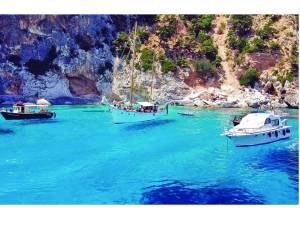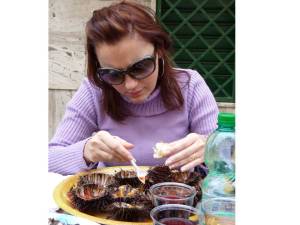Below is the Program for the Conference MUMMIES, BONES, and ANCIENT PATHOGENS to be held in Sardinia, Italy 7-8 September 2012. You can find a PDF for download at the bottom. I hope everyone has an incredible time!
Alyson
MUMMIES, BONES, and ANCIENT PATHOGENS: CONFERENCE PROGRAM
7-8 September 2012
STINTINO Palazzo Comunale, Sala Consiliare – Stintino, Sardinia, Italy
DAY 1
9:45-10:15 Opening of the Meeting
Salvatore Rubino, Co-chair Organizing Committee
Antonio Diana, Mayor of Stintino
Francesco Tamponi, Responsabile Regionale per i beni culturali ecclesiastici
Daniela Rovina, Soprintendenza Archeologica per le Provincie di Sassari e Nuoro
Attilio Mastino, Rector, University of Sassari
10:15-12:00 Session I: Archaic and Modern Genomes
Piero Cappuccinelli (Session Chair) Introductory remarks
10:15-10:45
Susanna Sawyer
Department Evolutionary Genetics, Max-Planck-Institute for Evolutionary Anthropology, Leipzig, Germany
Archaic Genomes: A Story Written in Neanderthal and Denisova DNA
10:45-11:15
Carsten Pusch
Institute of Human Genetics, Division of Molecular Genetics, University of Tübingen, Tübingen, Germany
First Insights into the Metagenome of Ancient Egyptian Mummies Using Next Generation Sequencing
11:15-11:30 Coffee break
11:30-12:00
Paolo Francalacci
Dipartimento di Scienze della Natura e del Territorio, University of Sassari, Sassari, Italy
Placing the Sequence of “Ötzi the Iceman” in the High Resolution Y chromosome Phlylogeny by Whole Genome Sequencing
12:00-15:15 Session II: Evolutionary Medicine, Ancient Pathogens and Pathologies
David Kelvin (Session Chair) Introductory remarks
12:00-12:30
Bernardino Fantini
Institute for the History of Medicine and Health, Faculty of Medicine, University of Geneva, Geneva, Switzerland
The Convergence of Genomic Studies and Historical Analysis of Infectious Diseases: the Case of Black Death
12:30-13:00
Marco Milanese
Dipartimento di Storia, Scienze dell’Uomo e della Formazione, University of Sassari, Sassari, Italy
The Biological Archives of Alghero: Archaeological Questions and Expectations from Biohistory and Biotechnology Projects in the Study of Human Remains from Urban Populations during the Thirteenth to the Seventeenth Centuries
13:00-14:30 Lunch Break
14:30-16:00 Session II: Evolutionary Medicine, Ancient Pathogens and Pathologies (Continued)
14:30-15:00
Gino Fornaciari
Division of Paleopathology, History of Medicine and Bioethics, Department of Oncology, Transplants and Advanced Technologies in Medicine
Medical School University of Pisa, Pisa, Italy
Cancer and Infectious Diseases: the Challenge of Soft Tissue Paleopathology
15:00-15:30
Frank Rühli
Centre for Evolutionary Medicine, Institute of Anatomy, University of Zurich, Zurich, Switzerland
Evolutionary Medicine: Ancient Mummies and More…
15:30-16:00 Coffee break
16:00-17:30 Session III: Ancient Pathogens
Giovani Fadda (Session Chair) Introductory remarks
16:00-16:30
Eugenia Tognotti
Dipartimento di Scienze Biomediche, Università degli Studi di Sassari, Sassari, Italy
Epidemics and Plagues in Sardinia from the 15th to the 20th Century
16:30-17:00
Raffaella Bianucci
Department of Anatomy, Pharmacology and Legal Medicine, University of Turin, Turin, Italy
Vector-Borne Diseases in Ancient Human Remains
17:00-17:30
Helen Donoghue
Centre for Infectious Diseases and International Health, University College London, London, UK
Insights into Ancient Tuberculosis and Leprosy
17:30-18:00 Sparkling Wine Cocktail (Brut/Prosecco!)
End of the first day
DAY 2
9:30-12:15 Session IV: Bioarchaeology, Modeling, and Perspectives on Ancient Pathogens
Mohammed Al Ahdal and Marco Milanese (Session Chairs): Introductory remarks
Archaeology of Sant’Imbenia
9:30-9:40
Elisabetta Garau, Marco Rendeli
Dipartimento di Storia, Scienze dell’Uomo e della Formazione, University of Sassari, Sassari, Italy
Seeds for Thought: Overview of the Archaeology of Sant’Imbenia
9:40-9:50
Rossella Filigheddu
Dipartimento di Scienze della Natura e del Territorio, University of Sassari, Sassari, Italy
Phenotypic Analysis of Seeds from Sant’Imbenia
9:50-10:00
Alberto Leon
University Health Network, Toronto, Canada
Summary of Sequencing of Seeds from Sant’Imbenia
Analysis of a Crypt of Sant’Antonio Abate Cathedral, Castelsardo
10:00-10:10
Franco Campus
Dipartimento di Storia, Scienze dell’Uomo e della Formazione, University of Sassari, Sassari, Italy
Bioarcheaology of a Crypt of Sant’Antonio Abate Cathedral, Castelsardo
10:10-10:20
Andrea Montella, Vittorio Mazzarello
Dipartimento di Scienze Biomediche, University of Sassari, Sassari, Italy
Histological Analysis of Mummified Tissue from the Crypt of Sant’Antonio Abate Cathedral, Castelsardo
10:20-10:30
Luca Simbula, Gianni Meloni, Paolo Lampus
Dipartimento di Scienze Chirurgiche, Microchirurgiche e Mediche, University of Sassari, Sassari, Italy
X-Ray Examination of Mummies and Bones from a Crypt of Sant’Antonio Abate Cathedral, Castelsardo
10:30-10:40
Cristiano Farace, Roberto Madeddu
Dipartimento di Scienze Biomediche, University of Sassari, Sassari, Italy
A Possible Estimation of Historical Pollution Increases by Heavy Metals Analysis in Ancient Bones: Emerging Data from Castelsardo Mummies and Comparison with Mummies from Other Centuries
10:40-10:50
Manuela Murgia, Bianca Paglietti
Dipartimento di Scienze Biomediche, University of Sassari, Sassari, Italy
Identification of Sporigens in a Crypt of Sant’Antonio Abate Cathedral, Castelsardo
10:50-11:00
Claudia Viganò, Patrizia Marongiu
Dipartimento di Scienze Biomediche, University of Sassari, Sassari, Italy
Analysis of Pathogens Using PCR of Biomaterial from a Crypt of Sant’Antonio Abate Cathedral, Castelsardo
11:00-11:20 Coffee
11:20-11:30
Luca Ruiu, Ignazio Floris
Dipartimento di Agraria, University of Sassari, Sassari, Italy
First Report of Insects and Other Arthropods on the Mummies Found inside a Crypt of the Castelsardo Cathedral (Sardinia, Italy)
11:30-11:40
Nikki Kelvin
Dipartimento di Storia, Scienze dell’Uomo e della Formazione, University of Sassari, Sassari, Italy
Mother-and-Infant Deaths from a Crypt of Sant’Antonio Abate Cathedral, Castelsardo
Historical Modelling and Perspectives
11:40-11:50
Alessandro Ponzelleti
Art Historian, Sassari, Italy
Practices and Burial Crypts in Churches of Sardinia: Some Examples
11:50-12:00
Luca Sanna
Dipartimento di Storia, Scienze dell’Uomo e della Formazione, University of Sassari, Sassari, Italy
An Integrated Bioarchaeology Project in North-West Sardinia: the Contribution of Preventive Archeology
12:00-12:10
Dario Piombino-Mascali
EURAC, Bolzano, Italy
The Sicily Mummy Project
12:10-12:20
Giampaolo Piga, Assumpciò Malgosa, Antonio Brunetti, Simona Spada, Stefano Enzo.
Dipartimento di Chimica e Farmacia, University of Sassari, Sassari, Italy
Anthropological and Chemico-Physical Studies on the Mummies of Peter II of Aragon and Blanca d’Anjou
12:20-12:30
Pierre-Olivier Méthot
Institute for the History of Medicine and Health, Geneva University, Geneva, Switzerland
What is a Pathogen? Perspectives (and Problems) from Medical Bacteriology and Pathogenomics
12:30-12:50 Concluding Remarks
David Kelvin
A Cryptic Approach to Future Studies
Salvatore Rubino
Closing Remarks
End of the Meeting
Organizing Committee
Salvatore Rubino (Co-Chair), David Kelvin (Co-Chair)
Attilio Mastino, Marco Milanese, Bruno Masala, Nikki Kelvin, and Andrea Montella
Sponsors
University of Sassari
• “International PhD School in Biomolecular and Biotechnological Sciences”
• Dipartimento di Scienze Biomediche
• Scuola di Dottorato, “Storia, Letterature e Cultura Mediterraneo”
International Sponsors
• University Health Network, Toronto, Canada
• IDR, Canada
• Shantou University Medical School, Shantou, China
• Journal of Infection in Developing Countries
This meeting is in celebration of the 450th anniversary of the founding of the University of Sassari.
Organizing Secretariat: Segreteria Dipartimento di Scienze Biomediche, Viale San Pietro 43 B, 07100 Sassari segrdip@uniss.it
To register or receive more information or submit an abstract: rubino(at)uniss(dot)it or nkelvin(at)jidc(dot)org









